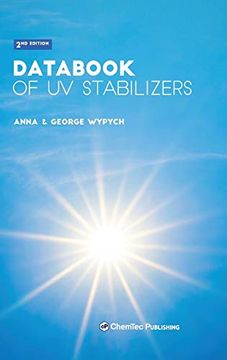Synopsis "Databook of uv Stabilizers"
The databook contains information on the most frequently used UV stabilizers. Current UV stabilizers are the result of many recent changes, especially in application to cosmetics, polymers, and plastics. Many current issues are related to health. Skin penetration by nano-stabilizers, suitability of spray systems to nano-compounds, the formation of toxic degradation products, the stability of stabilizers, and the effect of converted energy of radiation to heat on the increased temperature of skin are the most studied factors in the evaluation of these products. Many new groups of UV stabilizers and their mixtures are now available, resulting in a drastic increase in the number of stabilizer groups from 20 to 28, which in part shows progress in developments and growing interest in the protection of engineered products. The information on each stabilizer included in the Databook of UV Stabilizers is divided into five sections: General information, Physical properties, Health and safety, Environmental effect, and Use & performance. The data belong to over 100 data fields, which accommodate a variety of data available in source publications. The description of general sections below gives more detail on the composition of information.In General information section, the following data are displayed: Name, CAS #, EC number, Common name, Common synonym, Chemical formula, Chemical structure, Molecular weight, Chemical category, Product contents, and RTECS number. Physical properties section contains data on State, Form, Odor, Color description, Platinum-cobalt scale number, Color CIE L, Acid dissociation constants, Base dissociation constant, Beginning of weight loss, Boiling point, Bulk density, Carbon black undertone, Enthalpy of vaporization, Freezing/melting temperature, Maximum UV absorbance, pH, Particle size, Physical state, Product form, Refractive index, Specific gravity, Solubility in water and solvents, Surface tension, Thermogravimetric analysis, Transmittance, Vapor pressure, Viscosity, Volatility. Health and safety section contains data on Flashpoint, Flashpoint method, Autoignition temperature, Hazardous decomposition products, NFPA Classification, NFPA Health, NFPA Flammability, NFPA Reactivity, HMIS Classification, HMIS Health, HMIS Fire, HMIS Reactivity, UN Risk Phrases, R, UN Safety Phrases, S, DOT Hazard Class, UN/NA hazard class, UN packaging group, UV number, ICAO/IATA Class, IMDG Class, TDG class, Proper shipping name, Rat oral LD50, Mouse oral LD50, Rabbit dermal LD50, Inhalation rat LC50, Skin irritation, Eye irritation (human), Ingestion, First aid: eyes, skin, and inhalation, Chronic effects, Target organs, Carcinogenicity (ACGIH, NIOSH, OSHA), Mutagenicity, Reproduction/developmental toxicity, and TLV - TWA 8h (ACGIH, NIOSH, OSHA).Ecological properties section contains data on Biodegradation probability, Aquatic toxicity LC (Algae, Rainbow trout, Bluegill sunfish, Fathead minnow, Zebrafish, and Daphnia magna), Bioaccumulation potential, Bioconcentration factor, Biodegradation probability, Hydroxyl rate, and Partition coefficients (log Koc, log Kow).Use & performance section contains information on Manufacturer, Outstanding properties, Potential substitute, Recommended for polymers, Typical applications, Processing methods, Concentrations used, Guidelines for use, Food approval, Conditions to avoid, and Costabilizers enhancing light stability.This book is an excellent companion to the Handbook of UV stabilizers which has also been published recently.

